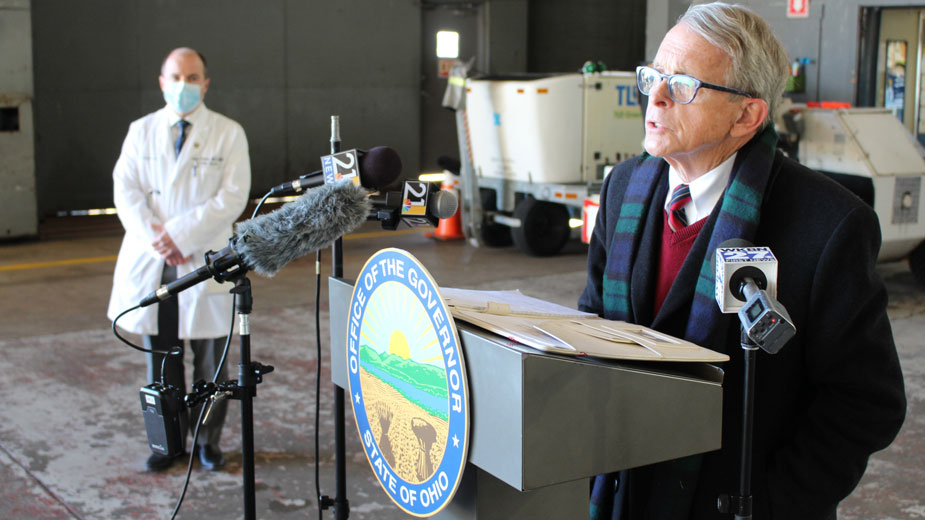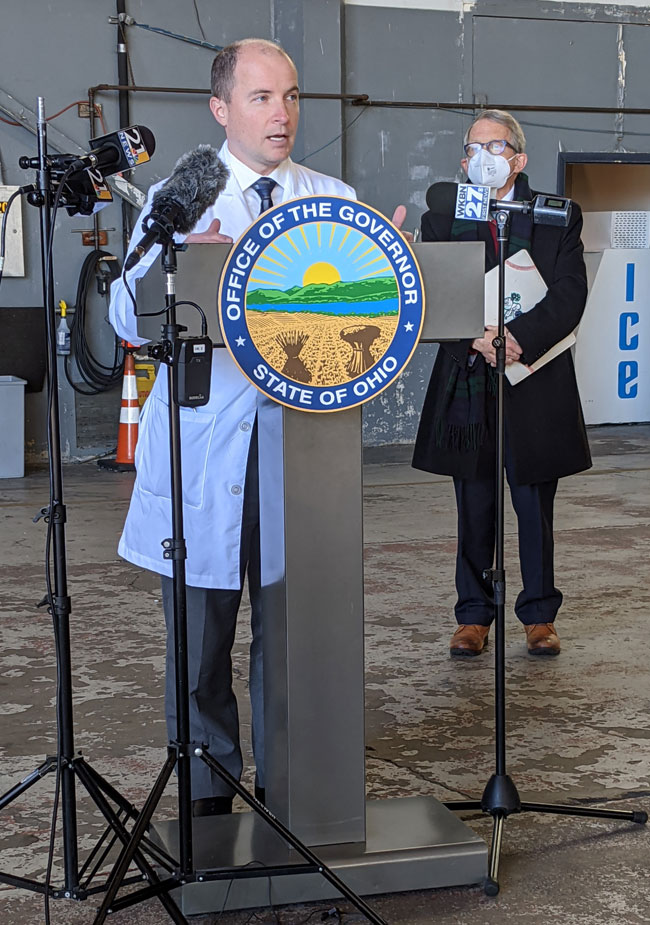DeWine: Mahoning Valley ‘Really on Fire’ from COVID-19
VIENNA TOWNSHIP, Ohio — Gov. Mike DeWine is doubling down on the state’s “slowdown not shutdown” approach to combating the coronavirus pandemic moving into the winter months, and he emphasizes it will require a concerted effort among all Ohioans.
“We don’t want to shut the economy down,” DeWine said. “We did this once. Doing it a second time will have a lot more impact than the first time. … So it’s really not a good option.”
During a press conference at the Youngstown-Warren Regional Airport Wednesday, the governor spoke to the press about the COVID-19 situation in the Mahoning Valley specifically and discussed some of the measures his administration has taken to curb the spread of the virus. The conference was closed to the public but can be watched in its entirety in the video above or on The Business Journal’s Facebook page.
“The Mahoning Valley is really on fire in regard to COVID,” DeWine said. As hard as the area was hit in the spring, it’s being hit “much harder than it ever was before,” he said.
Data from the past 14 days show that Mahoning, Columbiana and Trumbull counties are running at five times what the Centers for Disease Control and Prevention say is a high incidence level, he said. Per the CDC, a high incidence level is 100 cases per 100,000 people in two weeks.

The Mahoning Valley is at 528 cases per 100,000, he said. “That is exceedingly high. It’s not like anything we have seen before. And we’re seeing this throughout the state of Ohio,” he said.
In the last two weeks, the Mahoning Valley has recorded 2,794 positive tests, 101 hospital admissions and seven deaths, he reported. Death totals, he said, are a lagging indicator, rising about two weeks after cases do. And while most people will recover, “we know that the hospitalizations will go up just because of what’s happening with the cases,” he said, threatening schools, hospitals and nursing homes.
Northeastern Ohio and the Mahoning Valley are seeing a “steady increase in COVID-19 patients,” affirmed Dr. James Kravec, chief medical officer of Mercy Health-Youngstown and medical director of Mahoning County Public Health. Additionally, the health care community is seeing more cases that lead to hospitalizations, he said.
“This is worrisome,” he said. “In the spring and summer, larger cities saw this first. But now we’re seeing this in every county in Ohio.
“If people do not stop gathering in large groups, our hospitals will be overwhelmed,” he added.
Local hospital systems are already seeing the impact, he said. In an effort to help mitigate spread at Mercy’s hospitals, the health system last week halted visitations. Kravec voiced concern for hospital staff who are being exposed to the virus in the community and have to quarantine whether they test positive for the virus or not.
He commended the staff and care providers at Mercy and the larger health care community for the work they’ve done over the past nine months.
“I truly wish the general public could see the stress that the staff is under,” he said. “It really is stressing the health care system.”
Whereas space was the biggest concern among health systems in the spring, now it’s people, DeWine added. Spikes in cases throughout the northern part of the country have led to a scarcity of personnel, he said.
“So there’s no place for Youngstown to borrow nurses from,” he said. “You can’t get them from Pittsburgh, you can’t get them from Columbus, because they’re all busy. Same with doctors.”
Kravec and DeWine advised Ohioans to “pull back” on some of the things they’re used to doing. The governor suggested cutting back on doing things that lead to interactions with others, for example going to the grocery store once rather than two or three weekly trips.
Kravec said residents should start talking with the families now about Thanksgiving and the holiday season. He reiterated comments he made in a commentary published last week with Dr. John Luellen, Mercy Health-Youngstown’s president.

“Please reconsider how we celebrate Thanksgiving,” Kravec said. “I think it’s very important that we talk with our families now, and I’m doing that in my own family as recent as this morning having those difficult conversations.”
The goal is to limit gatherings to only people living in a household, he said.
The good news, DeWine said, is that two vaccines may come available in December and January. “This is really the first time throughout the pandemic that we have seen the light at the end,” he said.
The challenge, however, is building a bridge from today to when Ohio can start widely distributing the vaccines, he said. The governor expects that won’t happen until spring or summer of 2021.
Should the vaccine be approved, Ohio can likely expect its first shipment of 30,000 doses by December, he said. Those doses will be distributed initially to nursing home residents and staff to protect the most vulnerable population. Then the state will move on to front line hospital workers and go on from there, he said.
To get to that point, DeWine is asking Ohioans to rally like they did in the spring when the virus curve was flattened. “Valley residents have rallied before to flatten the curve. And we can certainly rally again,” he said.
Recent efforts to help mitigate the spread have seen progress, he said. The revised retail mask order issued last week, which includes retail mask-compliance inspectors, has led to more people wearing masks in businesses throughout the state, he said.
“We’ve already seen the use of masks going up in parts of the state, some of the rural parts of the state, where we had seen a very low compliance,” he said.
On Tuesday, DeWine announced a 10 p.m. curfew would take effect starting Nov. 19 and would run for 21 days. During the curfew, retail businesses will need to be closed and Ohioans will be expected to be home by 10 p.m. The curfew lifts at 5 a.m. daily.
The curfew will not apply to those going to or from work, those who have an emergency, or those who need medical care, nor is it intended to stop anyone from getting groceries or going to a pharmacy. Picking up carry-out or a drive-thru meal and ordering for delivery will be permitted, but serving food and drink in person must cease at 10 p.m.
“That cutting down of contact, we believe, will make a big difference,” he said.
He commented on bar crowds who wouldn’t be able to continue hanging out together past 10 p.m. “Some of us may go to bed at 10 p.m., but not everybody does,” he said. “Certainly young people many times do not.”
The curfew made national news Tuesday evening and into Wednesday. An article by Vox questioned the efficacy of curfews, citing European countries’ attempts to implement curfews didn’t work, leading those governments to issue stay-at-home orders.
The article cites Tara Smith, a public health professor at Kent State University, who said she’s seen no evidence of curfews helping mitigate the spread of COVID-19.
“I’ve not seen a single public health person recommend this as an intervention. I’m mystified at their popularity,” she said.
DeWine asserts the curfew is a component of the state’s larger effort to mitigate the spread of the virus. He consulted with doctors and other health care professionals when making the decision about the curfew.
“It’s simple math. The more contact there is, the more spread. The less contact there is, the less spread,” he said. “This is a dramatic act. It is sending a signal that we’ve got to get serious about this.”
Currently, people are still out socializing late into the evening, he said. The governor’s office has gotten reports that even after restaurants and bars stop serving alcohol by 10 p.m. per the state’s mandate, customers will continue to sit and talk, or will go someplace else to spend time together, he said.
“They no longer, legally, will be able to do that,” he said. “They will need to go home.”
DeWine said he doesn’t expect police to start pulling people over if they’re out driving at 10 p.m.
“But if the police see someone, a bunch of people gathered together at 10:30 at night at a filling station or at a park or someplace else, I would certainly expect police to go over and say, ‘Hey. Time to go home,’ ” he said. “That’s what we’re trying to accomplish.”
Mercy’s Kravec added that there’s “nothing magical” about 10 p.m. and the virus. The exact time isn’t the point of the curfew, he said, rather it’s limiting the number of hours where people can interact with each other.
“Where we are now is where we were in March,” he said. “We need to do things to stop getting together.”
What is done now will impact what happens a few weeks from now, Kravec said, “And that’s specifically important to me as I look at the hospitalization rate that we’ve seen in the community.”
Even for individuals who recover, there’s the risk of being a long-hauler with lingering side effects, he said.
“They may have complications. They may have heart problems, or liver problems, breathing problems,” he said. “One in five patients that have had a positive COVID test has some sort of behavioral health or anxiety, depression problems that are new.”
Copyright 2024 The Business Journal, Youngstown, Ohio.


